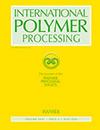Vulcanization kinetics and mechanical properties of filled ethylene-vinyl acetate copolymer rubber composites
IF 1.1
4区 工程技术
Q4 ENGINEERING, CHEMICAL
引用次数: 0
Abstract
Abstract The vulcanization reaction of ethylene vinyl acetate copolymer (EVM) rubber is fast, resulting in poor processing safety. EVM is often filled with flame-retardant fillers as insulating or sheathing material for wires and cables. Herein, the effects of flame-retardant magnesium hydroxide (Mg(OH)2), aluminum hydroxide (Al(OH)3) and of the traditional reinforcing fillers carbon black (CB) and silicon dioxide (SiO2) on the vulcanization kinetics of EVM were investigated. The vulcanization characteristics showed that the scorch time (T 10) of the unfilled EVM (KB), SiO2/EVM, Mg(OH)2/EVM, and Al(OH)3/EVM composites was about 1.75 min. T 10 of the CB/EVM composite was 2.22 min. Compared with KB, the activation energy (E a ) increased by about 15 kJ/mol for CB/EVM composites and by about 5 kJ/mol for SiO2/EVM, Mg(OH)2/EVM and Al(OH)3/EVM composites. The results indicate that CB delays the vulcanization time of EVM rubber, slows down the rate of vulcanization reaction and improves the safety of vulcanization. The addition of SiO2, Mg(OH)2 and Al(OH)3 has little effect on the vulcanization reaction. The mechanical properties show that CB/EVM is more uniformly vulcanized and has the best mechanical properties with a tensile strength of 17.61 MPa and elongation at break of 404.58 %. Mg(OH)2/EVM and Al(OH)3/EVM samples have prominent vulcanization non-uniformity resulting in poor mechanical properties.填充乙烯-醋酸乙烯共聚物橡胶复合材料的硫化动力学和力学性能
摘要乙烯-醋酸乙烯共聚物(EVM)橡胶硫化反应快,加工安全性差。EVM通常填充阻燃填料,作为电线和电缆的绝缘或护套材料。本文研究了阻燃氢氧化镁(Mg(OH)2)、氢氧化铝(Al(OH)3)以及传统增强填料炭黑(CB)和二氧化硅(SiO2)对EVM硫化动力学的影响。硫化特性表明,未填充的EVM(KB)、SiO2/EVM、Mg(OH)2/EVM和Al(OH)3/EVM复合材料的焦烧时间(T10)约为1.75 CB/EVM复合材料的最小T10为2.22 min。与KB相比,活化能(EA)增加了约15 CB/EVM复合材料的kJ/mol和大约5 对于SiO2/EVM、Mg(OH)2/EVM和Al(OH)3/EVM复合材料。结果表明,CB能延缓EVM橡胶的硫化时间,减缓硫化反应速率,提高硫化安全性。SiO2、Mg(OH)2和Al(OH)3的加入对硫化反应影响不大。力学性能表明,CB/EVM硫化更均匀,具有最好的力学性能,拉伸强度为17.61 MPa,断裂伸长率404.58 %. Mg(OH)2/EVM和Al(OH)3/EVM样品具有显著的硫化不均匀性,导致较差的机械性能。
本文章由计算机程序翻译,如有差异,请以英文原文为准。
求助全文
约1分钟内获得全文
求助全文
来源期刊

International Polymer Processing
工程技术-高分子科学
CiteScore
2.20
自引率
7.70%
发文量
62
审稿时长
6 months
期刊介绍:
International Polymer Processing offers original research contributions, invited review papers and recent technological developments in processing thermoplastics, thermosets, elastomers and fibers as well as polymer reaction engineering. For more than 25 years International Polymer Processing, the journal of the Polymer Processing Society, provides strictly peer-reviewed, high-quality articles and rapid communications from the leading experts around the world.
 求助内容:
求助内容: 应助结果提醒方式:
应助结果提醒方式:


